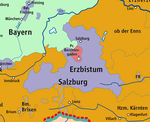Dokumentationszentrum Obersalzberg
1999 establishments in GermanyBerchtesgadener LandHistoriography of Nazi GermanyMuseums established in 1999Museums in Bavaria ... and 1 more
World War II museums in Germany

Dokumentation Obersalzberg is a museum in the Obersalzberg resort near Berchtesgaden, providing information on the use of the mountainside retreat by Nazi leaders, especially Adolf Hitler who regularly spent time in this area beginning in 1928. The museum was opened in 1999, and by 2007 had been visited by more than one million people.
Excerpt from the Wikipedia article Dokumentationszentrum Obersalzberg (License: CC BY-SA 3.0, Authors, Images).Dokumentationszentrum Obersalzberg
Salzbergstraße,
Geographical coordinates (GPS) Address Website External links Nearby Places Show on map
Geographical coordinates (GPS)
| Latitude | Longitude |
|---|---|
| N 47.6316 ° | E 13.0403 ° |
Address
Dokumentation Obersalzberg
Salzbergstraße 41
83471
Bavaria, Germany
Open on Google Maps










